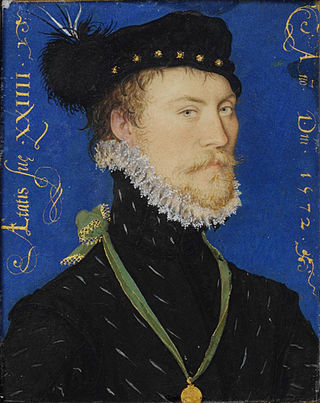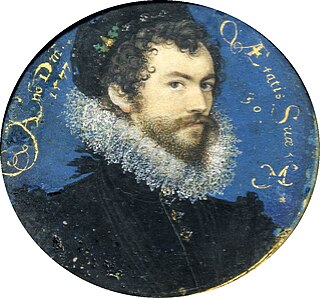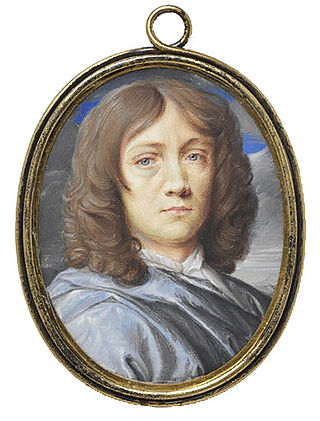Related Research Articles

Hans Holbein the Younger was a German-Swiss painter and printmaker who worked in a Northern Renaissance style, and is considered one of the greatest portraitists of the 16th century. He also produced religious art, satire, and Reformation propaganda, and he made a significant contribution to the history of book design. He is called "the Younger" to distinguish him from his father Hans Holbein the Elder, an accomplished painter of the Late Gothic school.

Gilbert Charles Stuart was an American painter from Rhode Island Colony who is widely considered one of America's foremost portraitists. His best-known work is an unfinished portrait of George Washington, begun in 1796, which is sometimes referred to as the Athenaeum Portrait. Stuart retained the portrait and used it to paint scores of copies that were commissioned by patrons in America and abroad. The image of George Washington featured in the painting has appeared on the United States one-dollar bill for more than a century and on various postage stamps of the 19th century and early 20th century.
Events from the year 1873 in art.

A portrait miniature is a miniature portrait painting, usually executed in gouache, watercolor, or enamel. Portrait miniatures developed out of the techniques of the miniatures in illuminated manuscripts, and were popular among 16th-century elites, mainly in England and France, and spread across the rest of Europe from the middle of the 18th century, remaining highly popular until the development of daguerreotypes and photography in the mid-19th century. They were usually intimate gifts given within the family, or by hopeful males in courtship, but some rulers, such as James I of England, gave large numbers as diplomatic or political gifts. They were especially likely to be painted when a family member was going to be absent for significant periods, whether a husband or son going to war or emigrating, or a daughter getting married.

Nicholas Hilliard was an English goldsmith and limner best known for his portrait miniatures of members of the courts of Elizabeth I and James I of England. He mostly painted small oval miniatures, but also some larger cabinet miniatures, up to about 10 inches tall, and at least two famous half-length panel portraits of Elizabeth. He enjoyed continuing success as an artist, and continuing financial troubles, for forty-five years. His paintings still exemplify the visual image of Elizabethan England, very different from that of most of Europe in the late sixteenth century. Technically he was very conservative by European standards, but his paintings are superbly executed and have a freshness and charm that has ensured his continuing reputation as "the central artistic figure of the Elizabethan age, the only English painter whose work reflects, in its delicate microcosm, the world of Shakespeare's earlier plays."

Jacques Joseph Tissot, anglicized as James Tissot, was a French painter and illustrator. He was a successful painter of fashionable, modern scenes and society life in Paris before moving to London in 1871. A friend and mentor of the Impressionist painter Edgar Degas, Tissot also painted scenes and figures from the Bible.

Thomas Flatman was an English poet and miniature painter. There were several editions of his Poems and Songs (1674). One of his self-portraits is in the Victoria and Albert Museum. A portrait of Charles II is in the Wallace Collection, London. His miniatures are noted for their vitality.
Events from the year 1847 in art.

Sir Leslie Matthew Ward was a British portrait artist and caricaturist who over four decades painted 1,325 portraits which were regularly published by Vanity Fair, under the pseudonyms "Spy" and "Drawl". The portraits were produced as watercolours and turned into chromolithographs for publication in the magazine. These were then usually reproduced on better paper and sold as prints. Such was his influence in the genre that all Vanity Fair caricatures are sometimes referred to as "Spy cartoons" regardless of who the artist actually was.
Events from the year 1835 in art.

Portrait Painting is a genre in painting, where the intent is to represent a specific human subject. The term 'portrait painting' can also describe the actual painted portrait. Portraitists may create their work by commission, for public and private persons, or they may be inspired by admiration or affection for the subject. Portraits often serve as important state and family records, as well as remembrances.
Events in the year 1813 in Art.
Sir William Charles Ross was an English portrait and portrait miniature painter of Scottish descent; early in his career, he was known for historical paintings. He became a member of the Royal Academy in 1842.
Events from the year 1740 in art.
Events from the year 1775 in art.

Charles Hayter was an English painter.

John Doyle, known by the pen name H. B., was an Irish political cartoonist, caricaturist, painter and lithographer.
Heaphy may refer to:
Thomas Heaphy the Elder (1775–1835) was an English water-colour painter, known also for his portraits.
James Holmes was a painter in oil and water colour of genre scenes and miniatures.
References
- ↑ O'Donoghue, Freeman Marius (1891). . In Stephen, Leslie; Lee, Sidney (eds.). Dictionary of National Biography . Vol. 25. London: Smith, Elder & Co. pp. 333–334.
- ↑ "Heaphy at V&A" . Retrieved 16 July 2014.
- ↑ "Heaphy at NPG, London" . Retrieved 16 July 2014.